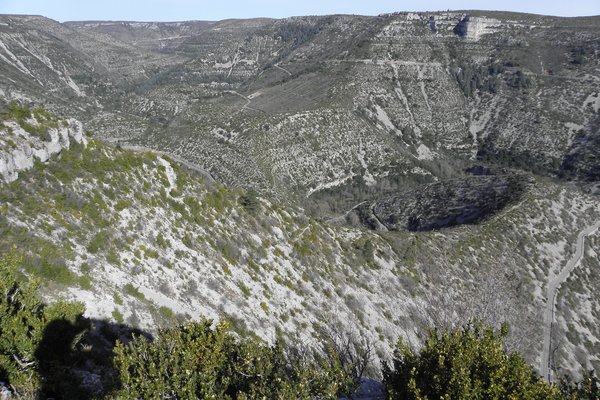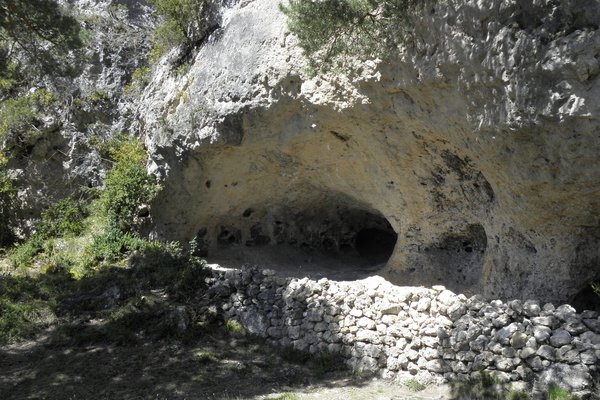France
Causses and Cévennes
The Causses and the Cévennes, Mediterranean agro-pastoral Cultural Landscape has evolved over three millennia due to farming and breeding of sheep.
It is located in the higher regions of the Massif Central, in an area of granite and limestone slopes and deep valleys. It is known for its chestnut farming and mulberry cultivation. Local breeds of sheep graze on open common land.
Community Perspective: The natural aspects of this area are much more appealing (and easier to recognize) than the agro-pastoral. See the reviews by Els, Hubert and Frederik for some ideas on what to see and do.
Site Info
Official Information
- Full Name
- The Causses and the Cévennes, Mediterranean agro-pastoral Cultural Landscape (ID: 1153)
- Country
- France
- Status
-
Inscribed 2011
Site history
History of Causses and Cévennes
- 2011: Advisory Body overruled
- ICOMOS had suggested deferral
- 2011: Inscribed
- Inscribed
- 2009: Referred
- More focus on agro-pastoralism
- 2006: Referred
- No explanation given
- Type
- Cultural
- Criteria
- iii
- v
Links
- UNESCO
- whc.unesco.org
- Official
-
- causses-et-cevennes.fr — Causses and Cevennes
- Related
-
- gutenberg.org — Downloadable version of RL Stevenson's Travels with a Donkey in the Cevennes on Project Gutenberg
- aven-armand.com — Aven Armand official website
- cevennes-gorges-du-tarn.com — Office de Tourisme des Gorges du Tarn et des Grands Causses
All Links
UNESCO.org
- whc.unesco.org — whc.unesco.org/
Official Website
- causses-et-cevennes.fr — Causses and Cevennes
Related Resources
- gutenberg.org — Downloadable version of RL Stevenson's Travels with a Donkey in the Cevennes on Project Gutenberg
- aven-armand.com — Aven Armand official website
- cevennes-gorges-du-tarn.com — Office de Tourisme des Gorges du Tarn et des Grands Causses
News Article
- Aug. 6, 2024 euro.dayfr.com — Nearly 80 dinosaur footprints, 200 million years old, found in Lozère
Community Information
- Community Category
- Cultural Landscape: Continuing
Travel Information
Toulouse Hotspot
Recent Connections
-
Obelisk
Monument/road marker at the Col de la S…
-
Honey Collection
"Ces landes ont un intérêt paysager ind… -
UNESCO Intangible Cultural Heritage Lists
Art of dry stone construction, knowledg…
Connections of Causses and Cévennes
- Geography
-
-
Canyons
Gorges du Tarn -
Cirques
Cirque de Navacelles, Cirque du Bout du Monde (Grande Causses) -
Dark-sky preserve
Parc national des Cévennes
-
- Trivia
-
-
Largest cultural WHS
302,319 ha (#5) -
Tour de France
Tour de France 2020, Stage 6 -
Slow Food Movement
Roquefort
-
- History
-
-
Knights Hospitaller
It was the leadership of the Knights Templar and Hospitaler that brought real development to the Causse plateaus. -
Knights Templar
It was the leadership of the Knights Templar and Hospitaler that brought real development to the Causse plateaus.
-
- Ecology
-
-
Reintroduced Species
Causse Méjan: Przewalski's horseSee www.takh.org
-
Dinosaur Remains
Grallator footprints in Cans-et-Cévennes -
Dripstone
Aven ArmandSee en.wikipedia.org
-
Natural Arches and Bridges
Chaos de Montpellier-le-VieuxSee fr.wikipedia.org
-
- Architecture
-
-
Dry Stone Construction
farmhouses
-
- World Heritage Process
-
-
First sites filling gaps cited by ICOMOS
transhumance 2011
-
Already inscribed still on T List
“Grotte Amélineau” and “Aven Armand,” parts of the TWHS “Ensemble de grottes à concrétions du Sud de la France.”
-
- Religion and Belief
-
-
Protestantism
In the 16th century Protestantism spread into the Cévennes along the trade routes from Geneva. Many merchants, traders and craftsmen became converts, forming islands of Protestantism amidst Catholic farmers. (AB ev)
-
- Human Activity
-
-
Irrigation and drainage
use of irrigated terraces for agriculture -
Silk Manufacture
mulberry cultivation -
Pastoralism
agro-pastoral Cultural Landscape, cattle and sheep -
Alpine ski areas in core zone
Some ski lifts and pistes at the "summit" of Mont Lozere -
Honey Collection
"Ces landes ont un intérêt paysager indéniable. Elles sont également importantes pour l’apiculture : en effet, la callune et la bruyère sont des espèces mellifères très recherchées pour la production du miel des Cévennes." (nom file) -
Transhumance
"The northern part of the Cévennes NP encompasses the grazed granite uplands around Mont Lozère. Here (is) .. good summer grazing by large flocks of sheep travelling north from farms to the south of the National Park in Languedoc near the coast, a system of transhumance that has persisted since the 12th century"
-
- Constructions
-
-
Via Ferrata
At Montpellier-le-Vieux -
Walled cities
La Couvertoirade -
Obelisk
Monument/road marker at the Col de la Serreyrède. It commemorates the fact that this pass was opened to pedestrians in the 11th century and to automobiles in 1887.
-
- WHS on Other Lists
-
-
UNESCO Intangible Cultural Heritage Lists
Art of dry stone construction, knowledge and techniques (2024)See ich.unesco.org
-
Most beautiful villages
La Couvertoirade is among Les plus beaux villages de France ('France's most beautiful villages') -
World Biosphere Reserves
Cévennes National Park
-
- Timeline
-
-
Built in the 12th century
The fundamental changes to the landscape that can still be perceived today took place between the 12th and 14th centuries when several monastic orders, including Benedictines, Hospitaliers and Knights Templars gained control of extensive lands (AB ev)
-
- WHS Hotspots
-
-
Provence hotspot
-
Toulouse Hotspot
Grands Causses : 201km by car
-
- WHS Names
-
-
Named after Queen Victoria
Édouard Martel named one of the rocks after Queen Victoria, to celebrate the Entente cordiale
-
News
- euro.dayfr.com 08/06/2024
- Nearly 80 dinosaur footprints, 200…
Recent Visitors
Visitors of Causses and Cévennes
- Aitia
- Albert
- Alexander Barabanov
- alicemears
- A. Mehmet Haksever
- Ammon Watkins
- Angela Vandyck
- Argo
- Aspasia
- Atila Ege
- AustralLights
- Badwater
- Bauchat
- BaziFettehenne
- Bin
- Cheryl
- ChrisN
- Christian Wagner
- christof
- Christoph
- Christravelblog
- Clyde
- Csaba Nováczky
- Dagmara
- Dani Cyr
- Daniela Hohmann
- Daniel Chazad
- Daniel R-F
- Dan Pettigrew
- David Aaronson
- Delphine Delaunay
- Dimitar Krastev
- Dirk-pieter
- Dolemite92
- Dwight Zehuan Xiao
- Echwel
- Els Slots
- Erik Jelinek
- fabi-ddorf
- Fan Yibo
- Femke Roos
- Frederik Dawson
- frizzle
- GeorgeIng61
- Hadrianus
- HaraldOest
- Harry Mitsidis
- Hasco
- Hubert
- Iain Jackson
- Ivan Rucek
- Jaakkotoivanen
- Jakob F.
- Jan-Willem
- Jarek Pokrzywnicki
- Jasam
- Jean Lecaillon
- Jeanne OGrady
- Jens
- Jezza
- Joel on the Road
- Jonas Kremer
- jonathanfr
- JoStof
- KarenBMoore
- Kbecq
- Lara Adler
- Loic Pedras
- Luis Filipe Gaspar
- Maciej Gil
- Małgosia Łupicka
- Manuelfunk
- marc Rouserez
- Marinemajor
- MAURO PODDA PANI
- MaxHeAnouBen
- Mikko
- Monica Tasciotti
- MoPython
- Mstrebl1990
- Nasebaer
- Niall Sclater
- Nihal Ege
- Nikolay Marinov
- Patrik
- Paul Schofield
- Peltzi
- PeterH
- Peter Lööv
- Philipp Leu
- Philipp Peterer
- Pieter Dijkshoorn
- Piotr Wasil
- Purrfect
- Ralf Regele
- Randi Thomsen
- Reisedachs
- RobRos
- Roel Sterken
- Roger Ourset
- Roman Bruehwiler
- Sabrina Liebehentschel
- Schnitzel
- scubarrie
- Sergio Arjona
- Shandos Cleaver
- Shijie ZHU
- sibariam
- SirLoydd
- Solivagant
- Stijn
- Svein Elias
- Szucs Tamas
- Taotao Chen
- Thomas Buechler
- Thomas van der Walt
- Tim Allen
- tony0001
- Tsunami
- Vanessa Buechler
- Walter
- Wieland
- WILLIAM RICH
- Wojciech Fedoruk
- Wo_ko
- Xander Huang
- Zach
- Zoë Sheng
Community Reviews
Show full reviews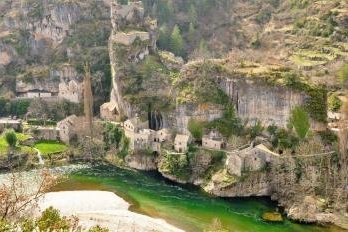
The World Heritage Site of Causses and Cévennes was not part of the original plan that my friend and I planned to visit during our trip to Pyrenes, the photos that we searched on Google and the reviews were not inspiring for an extra day detour until we found out that the must go of this cultural landscape was the beautiful area of Gorges du Tarn especially the surrounding villages near Sainte Enimie. We entered this World Heritage Site from Ales, we found that the scenery was quite boring with hilly landscape of forest, nothing special except some poor maintenance French villages. The view changed when we reached the town of Florec, from here we started to see the unique landscape that made Causses and Cévennes to be listed by UNESCO, the very large limestone plateau. The deep valley around the plateau was very nice. When we reached the village of Ispagnac, the scenic road was built along the deep canyon of Gorges du Tarn that formed by Tarn River. The canyon was actually very nice and we really surprised to see such geographical phenomenon in France.
The first place that really worth to mention is the village of Castelbouc. The village is located on the opposite side of the river from the main road on the much lower level from the street view. Actually we could easy bypass this village without notice, fortunately that we saw three motorcycles parked on the small viewpoint ramp, …
Keep reading 0 comments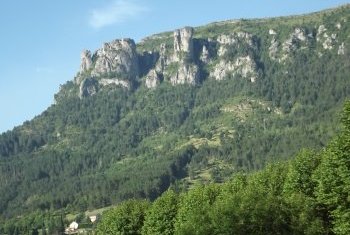
I spent several days travelling through this rugged area of the Massif Central. My journey started in Ales, from where I travelled by bus up the Gardon d'Ales and over the Jalcreste Pass to reach Florac in the Cevennes. Here the local mode of transport is the donkey, many named Modestine after the animal that accompanied Robert Louis Stevenson on his travels here. In evidence too are the Protestant churches of the Camisards whose forbears hid here during the periods of reepression. The town features the confluence of the Tarn and Tarnon Rivers, and is overlooked by the cliffs of the Causse Mejean.
My journey continued on another bus, this one crossing the Montmirat pass on the flank of Mont Lozere, and finishing at the town of Mende, on the banks of the Lot River.
Yet another bus took me from Mende to Marvejols, following the valley of the Lot and the Causse Sauveterre.
From Marvejols I continued by train to Millau, with spectacular views of the Grand Causses and glimpses of the Tarn Gorge.
Millau was spectacular for the views afforded of the viaduct. Passing beneath the viaduct on a side trip to Saint Affrique gave another perspective.
Keep reading 0 comments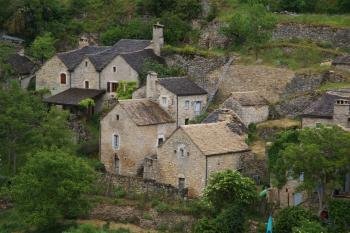
The agro-pastoral landscape of the Causses and Cevennes spreads over a wide area and consists of high plains (Causse Méjan, Causse Noir, Causse du Larzac), mountain ranges (Cevennes, Mont Lozère, Mont Aigoual) and narrow gorges (Gorges du Tarn, Gorges de la Jonte). Not easy to figure out which sites are worthwhile to get the best impression of both the natural heritage and the rural architecture. Thus, I studied extensively the nomination dossier, identified some places that seemed to be the most interesting, and finally planned our route for the two days we had scheduled for this WHS.
We started early in the morning in Le Puy-en-Velay and after 1.5 hours we entered the core zone at the northern slopes of the Mont Lozère massif. The narrow road (D20) goes close past the highest summit of the massif, the Sommet de Finiels, to Le Pont-de-Montvert. We had a first stop near the summit for a short hike. Actually, it is a high plateau rather than a steep peak, a sparse and stony landscape with conifers and yellow broom. Apart from us there was nobody around and the morning fog made a bit of a spooky atmosphere. Le Pont-de-Montvert is one of the larger villages in the area. We bought some cheese and the obligatory baguette to get through the day, and continued our trip heading towards the Gorges du Tarn. We took the narrow road D35 and came past lonely barnyards and through small hamlets, and saw some typical examples of …
Keep reading 0 comments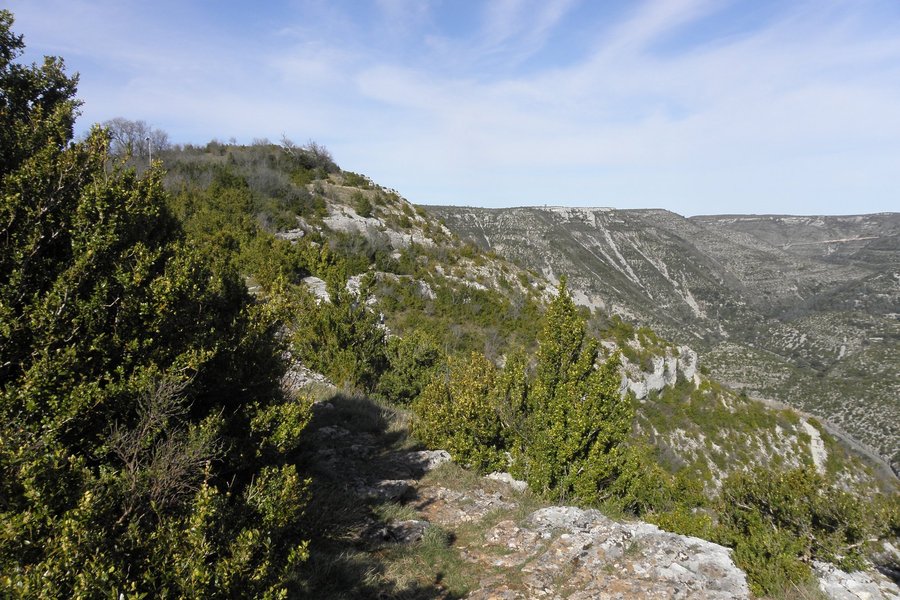
The Causses and the Cévennes cover a really large region, and as others have noticed, it is not immediately clear where to go to see its essence (it's a cultural landscape). Driving up north from Toulouse (which takes over 2 hours), I decided to take the highway from Lozère to Millau and take some detours from there. This highway already crosses the core zone by the way.
My first goal was to see the Cirque de Navacelles. These "Cirques" are one of the peculiar features of the landscape here. They are amphitheater-like valleys. Standing on the edge, it looks just like an enormous meteorite has landed. But it was all made by glacier erosion. This site lies about 28km from the main road. I also saw lots of large birds of prey (vultures?) circling there.
It was back to the main highway until I reached Millau. A small mountain road from there reaches further inland and finally ends at the Chaos of Montpellier-le-Vieux. This is a karst landscape with strangely shaped rocks, just like the Chinese love them. In the summertime, it is a very popular tourist site, but I only encountered one other couple in the parking lot.
I choose to do the 1.5-hour red hike around the park: a pleasure to just be outside in nature in this fine weather. At the end of that walk, I finally encountered two man-made constructions in the landscape that are pointed out in the description of this WHS: a cistern and …
Keep reading 0 comments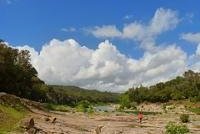
I visited this vast WHS in April 2012. I enjoyed the picturesque landscape contrasts of garigue, trees, streams, etc. Best to visit by car on a sunny day and then enjoy trekking and hiking in the countryside.
Keep reading 0 comments
